#100daysofseahorses
#the100dayproject
Over on Instagram I've created #100daysofseahorses over 100 days,
learning more about all the different species of seahorses.
Using data from the IUCN Redlist, creating from an artistic, aesthetic viewpoint, not a particularly scientific one. I’m hoping to understand more about seahorses while highlighting their vulnerabilities. Seahorses have fascinated me for a long time, with horse-like heads, tails like monkeys, eyes that move independently and the amazing ability to change colour like chameleons.
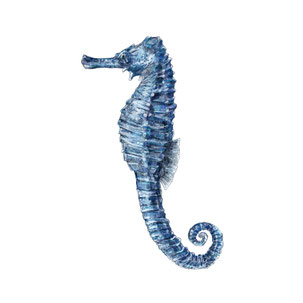
Day 1/100
Three-spot Seahorse (Hippocampus trimaculatus)
1. It is found in coastal waters around Australia, Cocos Islands, French Polynesia, Hong Kong, India, Indonesia, Japan, the Philippines, Singapore, Taiwan, Thailand, and Vietnam.
2. Growing to 10cm in length, its colour can be golden orange, sandy colored, or even totally black.
3. Not much is known about their exact numbers, however they are affected by habitat loss and are collected for use in Chinese traditional medicine. The IUCN Redlist states populations are decreasing, listing them as Vulnerable.

Day 2/100
Coleman's Pygmy Seahorse (Hippocampus colemani)
1. It is found off of the coast of Lord Howe Island, Australia,
2. They are tiny, growing to only 2.7cm with white circular or elliptical markings outlined with narrow red lines on the trunk, dusky brown bands radiating from the eye, brownish-red appendages, and a slightly brownish tail with red markings
3.Not much is known about threats to this species listed as Data Deficient on the IUCN Redlist with population trend unknown.

Day 3/100
False-eye seahorse (Hippocampus biocellatus)
1. Found in the Shark Bay region to Exmouth Gulf, Western Australia. It gets its name from the pair of "eye spots" on its back that confuses its predators.
2. Growing to 11cm with blotchy pale greyish to pale brown, with blackish scribbles and fine yellowish-cream spots, two distinct black ocelli surrounded with yellow laterally on upper sides of the trunk.
3. There is no known international trade for the aquarium industry and it is not listed on the IUCN Redlist.

Day 4/100
The knobby seahorse (Hippocampus breviceps)
1. It inhabits coastal waters in southwestern and southeastern Australia, from Gregory to Bremer Bay (Western Australia), and from Denial Bay (South Australia) to Newcastle (New South Wales).
2. Growing to 10cm with colouration ranging from drab grey to bright yellow-orange, with small black spots and ringed white ocelli over the trunk and tail.
3. It may be threatened locally by coastal development and is listed as Least Concern on the IUCN Redlist with population trend Unknown.

Day 5/100
Fisher’s seahorse (Hippocampus fisheri)
1. Found around Hawaii, previously misidentified around Australia and New Caledonia.
2. Grows to about 8cm in length.
3. Listed on the IUCN Redlist as Least Concern, population unknown.

Day 6/100
Lined Seahorse (Hippocampus erectus)
1. It lives in the western Atlantic Ocean as far north as Canada and as far south as the Caribbean, Mexico, and Venezuela.
2. It can grow up to 19cm in length with colours ranging from black, grey, brown, and green, to orange, red, and yellow.
3.Frequently caught as bycatch by shrimp trawlers and targeted for the aquarium trade, it is listed as Vulnerable on the IUCN Redlist with population trend decreasing.

Day 7/100
White's Seahorse (Hippocampus whitei) or
Highcrown seahorse (Hippocampus procerus)
1. Found along the east coast of Australia, Queensland to New South Wales.
2. Reaching a maximum size of 13cm they are generally pale to dark brown or black, although some are entirely yellow.
3. This species is protected in Australia, there has been no reported legal trade of them in the last five years although small numbers caught in bycatch may be illegally traded. With decreasing populations from habitat degradation it is listed on the IUCN Redlist as Endangered.

Day 8/100
Softcoral Seahorse (Hippocampus debelius)
1. Found in the soft corals around Egypt.
2. Around 2.4cm in length with dark brown or black tips.
3. This species is only known from two confirmed specimens; it is listed on the IUCN Redlist as Data Deficient, population decreasing.

Day 9/100
Short-snouted Seahorse (Hippocampus hippocampus)
1. It inhabits shallow coastal waters in the Northeastern Atlantic, from the UK and the Netherlands to Senegal and including the Mediterranean Sea and coastal waters of the Azores, Madeira, and the Canary Islands.
2. It can grow to 15cm in length and can be black, purple, orange or brown.
3. It is caught as bycatch and has continuing threats including habitat degradation and pollution. Listed as Data Deficient on the IUCN Redlist with population trend Unknown.

Day 10/100
Patagonian Seahorse (Hippocampus patagonicus)
1. It inhabits coastal waters from northeastern Brazil to Chubut, Argentina.
2. Typically growing between 6-15cm in length with colours ranging from pale to dark brown, yellow, red and orange.
3. Collected and sold as curios, for traditional chinese medicine and for the aquarium trade they are also threatened by habitat loss. Listed as Vulnerable on the IUCN Redlist with population trend decreasing.

Day 11/100
Flatface Seahorse (Hippocampus planifrons)
1. Found along the coast of Western Australia
2. May grow to 12cm in length normally greenish brown with a spotted snout, and dark blotching over the back of the trunk and tail.
3. It is of no interest to fisheries, and not traded in the Asian Traditional Medicine market, populations are unknown so it is listed on the IUCN Redlist as Least Concern.

Day 12/100
A new Seahorse (Hippocampus tyro)
1. The species is only known from a single specimen caught off of the coast of the Seychelles
2. Growing to 6.1cm with greyish white to light brown with whitish blotches, grading to light orangish brown posteriorly on the tail.
3. It may be threatened by coral reef habitat degradation and loss caused by coastal development and pollution, destructive fishing practices and the effects of climate change, it may also be taken as bycatch in trawl fisheries, but this is unknown. It is listed as Data Deficient on the IUCN Redlist with population trend Unknown

Day 13/100
Dwarf Seahorse (Hippocampus zosterae)
1. Found around Bermuda, the Bahamas, the Gulf of Mexico, the Florida Keys to Cancun, Mexico.
2. Growing to 5cm in length with good camouflage colours ranging from beige, yellow, green, and black and may have white speckles or dark spots.
3. This species may be particularly susceptible to decline due to seagrass degradation however is listed as Least Concern on the IUCN Redlist with population trend Stable

Day 14/100
Tiger Tail Seahorse (Hippocampus comes)
1. Found in coastal areas of the southeast Asian countries of Cambodia, Indonesia, Malaysia, Singapore, Thailand, Vietnam, the Philippines, and the Andaman Islands.
2. Growing to 10cm with a black and yellow tail with white dots around their eyes and cheeks.
3. The species is exploited to supply the traditional medicine, curio and aquarium trades and so are listed as Vulnerable on the IUCN Redlist with population trend Decreasing.

Day 15/100
Beibu Bay seahorse (Hippocampus casscsio)
1. It is found off the coast of Hainan, China.
2. Growing to 13.3cm with plain dark brown colouration.
3. Further research on the species' habitat is needed to determine whether other threats are also present, it is listed as Data Deficient on the IUCN Redlist with population trend Unknown.

Day 16/100
Sindo's Seahorse (Hippocampus sindonis)
1. Found around the coast of Japan and southern Korean peninsula
2. Growing to 10cm in length
3. Threatened by habitat loss, pollution and destructive fishing practices, listed as Least concern on the IUCN Redlist with population trend unknown.

Day 17/100
Winged seahorse (Hippocampus alatus)
1. Found in Northern Australia and southeastern Papua New Guinea.
2. Growing to 11.7cm in length with pale pinkish-white with numerous minute dark spots and broad reddish-grey saddle-like markings.
3.They are caught and discarded as bycatch by the prawn trawl fishery. There is no known international trade in the Winged Seahorse for the aquarium or Asian Traditional Medicine industries, the IUCN Redlist states populations are Decreasing, listing them as Vulnerable.

Day 18/100
#100daysofseahorses
Seahorse patterns from illustrations from days 1-17

Day 19/100
Knysna Seahorse (Hippocampus capensis)
1. Found in the Knysna, Swartvlei, and Keurbooms estuaries in South Africa, its limited range of this seahorse puts it at great risk of extinction.
2. Growing to 12cm with colouration strongly influenced by its environment and a particular individual's mood. It varies from pale green to brown, often with darker speckles, to purplish black.
3. It is vulnerable to water temperature increases and increased human use of its environment. Listed as Endangered on the IUCN Redlist with population trend Decreasing.

Day 20/100
Denise's pygmy seahorse (Hippocampus denise)
1. Native to the western Pacific
2. Grows to approximately 2.4cm, it’s coloration ranges from yellow, more or less bright, to orange with often small dark spots and sometimes darker bands on the tail.
3. The scope and severity of threats to this species has not yet been assessed, it is listed as Data Deficient on the IUCN Redlist with population trend Unknown.
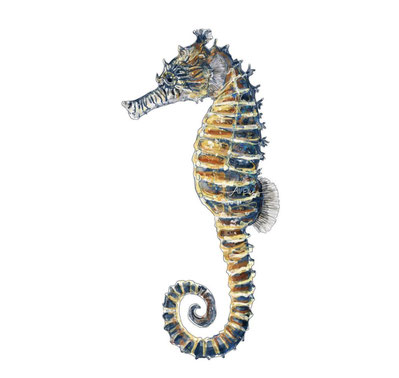
Day 21/100
West Australian Seahorse (Hippocampus subelongatus)
1. Found, as the name suggests, in coastal waters around south-western Australia.
2. Growing to 25cm in size they are well camouflaged seahorse varying in colour from brown, white, red, orange to purple, with a series of thin dark bars on the snout.
3. Collected by the aquarium trade and threatened by coastal habitat degeneration, they are listed as Data Deficient on the IUCN Redlist with population trend unknown.

Day 22/100
The paradoxical seahorse (Hippocampus paradoxus)
1. The only known specimen was captured in 1995 off the south west coast of Australia and remained unnoticed in a museum until 2006.
2. The specimen was a female, and has a height of 6.5 cm, yellow-cream in color, and it is covered with small brown spots.
3. The threats to this species and its habitat are unknown so it is listed as Data Deficient on the IUCN Redlist with population trend Unknown.

Day 23/100
Hedgehog Seahorse (Hippocampus spinosissimus)
1. Found in reefs and corals around the Philippines
2. Usually they grow to 12.5cm with a yellow-orange to deep red or dark brown snout, a dark front of head, and pale grey saddles or bands over the trunk and tail
3. This species is one of the two most heavily reported species in trade with decreasing populations it is listed on the IUCN Redlist as Vulnerable

Day 24/100
Réunion seahorse (Hippocampus borboniensis)
1. It is found in Madagascar, Mauritius, Mozambique, Réunion, South Africa, and Tanzania.
2. Growing to 17cm in length they can be all black in colour, or have a creamy. Pale yellow spotted body with large dark circles.
3. They are threatened by habitat loss but not listed on the IUCN Redlist. Sadly they are the most valuable species in the traditional Chinese medicine trade due to their size.

Day 25/100
Dwarf Thorny Seahorse (Hippocampus pusillus)
1. Found from New Caledonia and the Loyalty Islands.
2. There is no average size or colouration data available on this species.
3. The threats to this species are unknown so it is listed as Data Deficient on the IUCN Redlist with population trend Unknown.

Day 26/100
Zebra Seahorse (Hippocampus zebra)
1. Found in coastal areas of Australia, from Exmouth Gulf, Western Australia to the Swain Reefs at the southern end of the Great Barrier Reef.
2. Maximum record length 7.8cm with zebra-like markings may provide effective camouflage, alternating yellowish-white and brown to black bands.
3. It is threatened by coral reef habitat loss due to coastal development and pollution, destructive fishing practices, ocean acidification, and the effects of climate change. Listed as Data Deficient on the IUCN Redlist with population trend Decreasing.

Day 27/100
Walea pygmy seahorse (Hippocampus waleananus)
1. It lives only in the Tomini Gulf of central Sulawesi, Indonesia.
2. It is tiny, just 1.8cm in length with pale pinkish to yellow with red and brown blotches.
3. Threatened by coral reef habitat degradation and destructive fishing practices, listed as Data Deficient on the IUCN Redlist with population trend unknown.

Day 28/100
Barbour's Seahorse (Hippocampus barbouri)
1. Found in the shallow waters off the coast of Malaysia, Indonesia and the Philippines.
2. They grow to an average length of 11-15cm, they range in color from white to yellow to greenish gray to light brown, and some may have some reddish-brown spots or lines.
3. Threatened by exploitation this species is listed as Vulnerable with population trends decreasing on the IUCN Redlist

Day 29/100
Spotted, yellow, estuary, spotted Seahorse (Hippocampus kuda)
1. Found from the Persian Gulf to Southeast Asia, Australia, Japan, and some of the Pacific islands, including Hawaii, also been documented along the eastern coast of Africa from Tanzania to South Africa.
2. Growing to 17cm in length they can be all black in colour, or have a creamy. Pale yellow spotted body with large dark circles.
3. They are caught and traded for traditional medicines, aquaria and curios. They are also threatened by damage to its habitats Listed on the IUCN Redlist as Vulnerable with populations decreasing.

Day 30/100
Giraffe Seahorse (Hippocampus camelopardalis)
1. Found in waters off the south and east coasts of Africa from False Bay, South Africa to Zanzibar, Tanzania, and possibly further north to Mombasa, Kenya.
2. It can grow to 10cm with characteristics including dark spots.
3. It may be threatened due to seagrass and coral habitat loss due to coastal development and pollution. Listed as Data Deficient on the IUCN Redlist with population trend unknown.
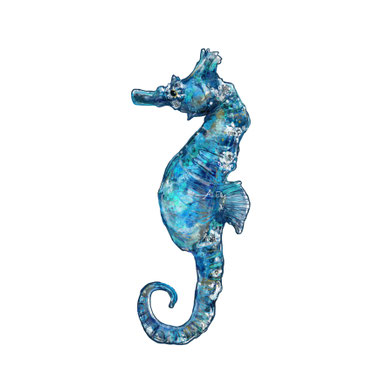
Day 31/100
High-crowned Seahorse (Hippocampus coronatus)
1. Found in the Northwest Pacific, endemic to Japan.
2. Growing to 13.3cm but more commonly 6cm
3. Threats and how they are impacting the species have not been quantified, listed as Data Deficient on the IUCN Redlist with population trend Unknown.

Day 32/100
Lichtenstein's seahorse (Hippocampus lichtensteinii)
1. Found in the Western Indian Ocean and the Red Sea.
2. Reaching 4cm in length with pale brown colour and without markings.
3. This species requires further investigation to ensure validity, so is not listed on the IUCN Redlist

Day 33/100
Sea pony (Hippocampus fuscus)
1. Found in the Indian Ocean, specifically the Red Sea, Saudi Arabia, Djibouti, and Sri Lanka.
2. Growing to a maximum length of 14.4cm, they are usually dark coloured but can be bright yellow.
3. Used in India for traditional medicines but not listed on the IUCN Redlist
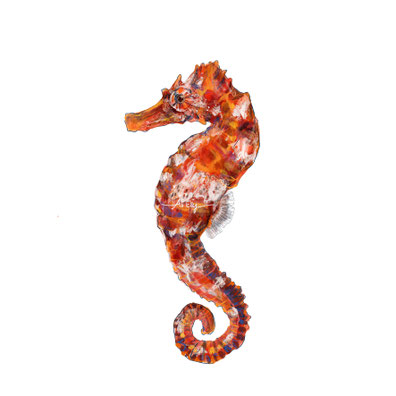
Day 34/100
Giant or Pacific Seahorse (Hippocampus ingens)
1. Found in the Eastern Pacific, from Long Beach, California through the Gulf of California to Peru, including the Cocos, Malpelo and Galápagos Islands
2. Growing to an average of 19cm but have been known to reach 30cm in length. They have a variety of colors, including green, brown, maroon, grey, and yellow.
3. This species may be particularly susceptible to decline resulting from degradation of habitat from coastal development, tourism and fisheries. Listed as Vulnerable on the IUCN Redlist with population trend Decreasing.

Day 35/100
West African Seahorse (Hippocampus algiricus)
1. It is found in the eastern central Atlantic Ocean.
2. This large seahorse grows to 19.2cm
3. Habitat degradation along the coast is also a concern for this shallow-intertidal species, listed as Vulnerable on the IUCN Redlist with population trend Decreasing.

Day 36/100
Long-snouted Seahorse (Hippocampus guttulatus)
1. Native from the northeast Atlantic, including the Mediterranean.
2. Reaching a maximum of 21.5 cm but more commonly 12cm, its colour ranges from dark green to different variants of brown to yellow, the body is often speckled with small white dots.
3. As it is a shallow coastal species it is extremely susceptible to anthropogenic activities, listed as Data Deficient on the IUCN Redlist with population trend Unknown.

Day 37/100
Narrow-bellied Seahorse (Hippocampus angustus)
1. Found in waters off of Australia, from Perth to Hervey Bay, and the southern portion of Papua New Guinea in the Torres Strait.
2. Growing to 22cm but average around 16cm long. Their colouration is generally grey to brownish, with white, yellow, orange or brown scribbly, net-like markings on the head and body.
3. This species is known to be caught as by-catch, they are listed as Least Concern on the IUCN Redlist with population trend Unknown.

Day 38/100
Thorny of Spiny Seahorse (Hippocampus histrix)
1. Native to the Indo-pacific area, occurring from southeastern Africa and Madagascar to Japan, Hawai'i, and French Polynesia
2. It can grow to 17cm in length with coloration that is highly variable to match surroundings and goes from grey to cream, and from bright yellow, to green or red and even brownish.
3. The major threat is over-exploitation, caught in both targeted fisheries and as bycatch in other non-selective fisheries, particularly shrimp trawls. They are listed as Vulnerable on the IUCN Redlist with population trend Decreasing.

Day 39/100
Lowcrown Seahorse (Hippocampus dahli)
1. Found in northern and northeastern Australia, from Darwin, Northern Territory, to Brisbane, Queensland
2. Growing to 20cm they are mostly pale brown to almost black, usually with small black scribble marks sometimes forming lined, zebra-like patterns.
3. Threatened by being caught as bycatch in trawl fisheries, so listed as Least Concern on the IUCN Redlist with population trend Unknown.

Day 40/100
Pot-bellied or Bigbellied Seahorse (Hippocampus abdominalis)
1. Found in waters of New Zealand and southern Australia, where it occurs from New South Wales, to South Australia, and south to Tasmania.
2. One of the larger seahorses it can grow to 35cm and range in colour from almost white to a mottled yellow, reddish or even brown, with irregular darker spots and blotches, and a broadly banded tail.
3. It is threatened by localized habitat loss and degradation due to coastal development and by being caught as bycatch in demersal trawl fisheries. Listed as Least Concern on the IUCN Redlist with population trend Unknown.

Day 41/100
Jayakar's seahorse (Hippocampus jayakari)
1. It is found in the Western Indian Ocean, from the Red and Arabian seas to the central coast of Pakistan.
2. Growing up to 14cm in length
3. Assessed as Least Concern by the IUCN Redlist with population trend unknown.

Day 42/100
Monte bello seahorse (Hippocampus montebelloensis)
1. Located as its name suggests, in reference to the Monte Bello Islands, Eastern Indian Ocean.
2. Maximum record length 7.8cm with zebra-like markings may provide effective camouflage, alternating yellowish-white and brown to black bands.
3. It is threatened by coral reef habitat loss due to coastal development and pollution, destructive fishing practices, ocean acidification, and the effects of climate change. Listed under Zebra Seahorse (Hippocampus zebra) Data Deficient on the IUCN Redlist with population trend Decreasing.
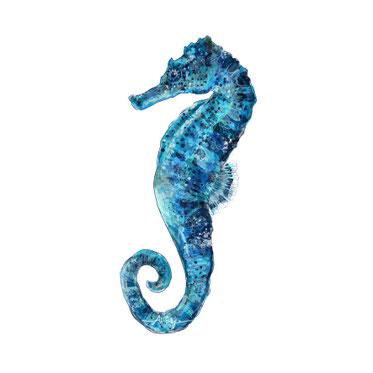
Day 43/100
Long-snout Seahorse (Hippocampus reidi)
1. Found in coastal waters in the western Atlantic from North Carolina south throughout the Gulf of Mexico and Caribbean Sea, and along South America to southern Brazil.
2. Growing to 17.5cm, Males are usually orange, while the females are yellow, both have brown or white spots that change into a pink or white color during the courtship.
3. It is also heavily targeted for the aquarium trade, listed as Near Threatened on the IUCN Redlist with population trend Decreasing.

Day 44/100
Bargibant’s Pygmy Seahorse (Hippocampus bargibanti)
1. This was the first species of pygmy seahorse to be discovered. They inhabit waters in the Indo-West Pacific from southern Sumatra to New Caledonia and from Tokyo, Japan, to the southern edge of Australia's Great Barrier Reef.
2. Growing to just 2.7cm in maximum length. There are two known color variations: grey with red tubercles, and yellow with orange tubercles.
3. They are extreme habitat specialists, spending their entire adult life on a single gorgonian coral of the species. This makes the species threatened by coral reef degradation and loss as a result of coastal development and pollution, listed as Data Deficient on the IUCN Redlist with population trend unknown.

Day 45/100
Japanese Seahorse (Hippocampus mohnikei)
1. For many years thought to only be found around Japan, however, it was recently observed off the coast of southeastern India.
2. Growing to 8cm in length they are usually dark brown in colour.
3. Threatened by overexploitation and habitat loss they are listed as Vulnerable on the IUCN Redlist with population trend decreasing

Day 46/100 #100daysofseahorses
Satomi's Pygmy Seahorse
1. Found in scattered localities around Indonesia, including Derawan, the Lembeh Strait, as well as northern Borneo, Malaysia
2. This is the smallest known seahorse in the world with an average adult length of 13.8 mm, it holds the Guinness world record for the world's smallest species of seahorse
3. Threatened by coral reef habitat degradation and destructive fishing practices, listed as Data Deficient on the IUCN Redlist with population trend unknown.

Day 47/100
Bullneck seahorse (Hippocampus minotaur)
1. The only known specimens were collected on the coast of Eden, Australia
2. Growing to 5.5cm in length, colouration is unknown.
3. The threats to this species are unknown so it is listed as Data Deficient on the IUCN Redlist with population trend Unknown.

Day 48/100 #100daysofseahorses
A seahorse pattern using the blue colours

Day 49/100 #100daysofseahorses
A pattern coloured theme is the designed from green/yellow shades of seahorses made into a pattern

Day 50/100 #100daysofseahorses
A pattern is designed with the warm orange and red shades of seahorses

Day 51/100
Pontoh`s Pygmy Seahorse (Hippocampus pontohi)
1. Native to the Indo-Pacifi
2. Growing to a maximum length of just 1.7cm, its large head represents about 25% of its body. Whitish in colour with pinkish, yellow markings.
3. Threats to this species are unknown and it is listed as Least Concern on the IUCN Redlist with population trend Unknown.

Day 52/100
Japanese pygmy seahorse (Hippocampus japapigu)
1. As its name suggests, it lives in the Northwestern Pacific near Japan.
2. It grows to a maximum of just 1.6cm in length, the size of a jellybean. It’s colouration brown, beige pink and whitish, made for hiding in algae-covered reefs, clinging to soft corals.
3. Very little is known about their biology and conservation. It is not listed on the IUCN Redlist.

Day 53/100
Sodwana Bay pygmy seahorse (Hippocampus nalu)
1. Found as the name suggests in the Sodwana Bay, off eastern South Africa.
2. This pygmy seahorse is the size of a grain of rice, approx 1.6cm, with a set of spines on its back. With honey brown colouration and a reddish tail to help camouflage.
3. Very little is known about their biology and conservation. It is not listed on the IUCN Redlist.

Day 54/100
Korean seahorse (Hippocampus haema)
1. Found in Korean waters, the scientific name haema is named from seahorse in Korean
2. It can grow to lengths of 11 centimeters
3. This species had been repeatedly misidentified as crowned seahorse and Shiho's seahorse before a taxonomic review. The two species however do not live in Korean waters, therefore this species was given the new scientific name. Very little is known about their biology and conservation. It is not listed on the IUCN Redlist.

Day 55/100 #100daysofseahorses
Making patterns with the favourite blue coloured seahorses

Day 56/100 #100daysofseahorses
More patterns, yellow seahorses today

Day 57/100 #100daysofseahorses
Todays seahorse pattern is more blues, this time the turquoise

Day 58/100 #100daysofseahorses
More patterns today, this time the colour themes are warmer, reds and oranges

Day 59/100
Collared seahorse (Hippocampus jugumus)
1. It was described in 2001 from a single specimen found in the waters surrounding Lord Howe Island.
2. Growing to 10cm in length, it is a small reddish seahorse with two more trunk rings than most other seahorse species
3. Not much is known about threats to this species listed as Data Deficient on the IUCN Redlist with population trend unknown
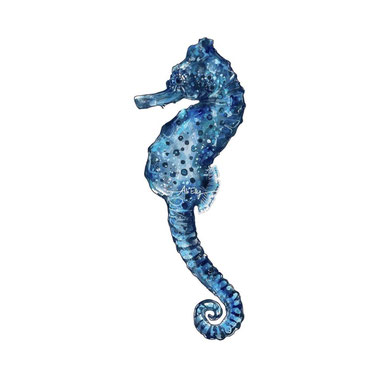
Day 60/100
Great Seahorse (Hippocampus kelloggi)
1. Found throughout much of the Indo-Pacific, recorded from Zanzibar in Tanzania, Pakistan, India, and southeast Asia, north to China and Japan and southwest to Queensland and Vanuatu in Australia
2. One of the largest seahorses it can grow up to 28cm in length changing colour for camouflage.
3. Threatened from bycatch and destructive fishing practices such as dynamite fishing and trawling . The species may also be targeted for use in the aquarium trade. Listed as Vulnerable on the IUCN Redlist with population trend decreasing.

Day 61/100
Eastern Spiny Seahorse (Hippocampus hendriki)
1. Found only in Queensland
2. Grows to 10.4cm in height with yellow darkening to pale orange on top and back
3. It is not evaluated by the IUCN, listed as Hippocampus angustus, Least Concern on the Redlist with population trend Unknown

Day 62/100
Ruby Seadragon (Phyllopteryx dewysea)
1. A newly described species from only 4 specimens collected off southwestern Australia, near Perth.
It is only the third known species of seadragon.
2. Growing to 23.5cm in length.
3. Normally found in deep waters, threats to this species are unknown so it is listed as Data Deficient on the IUCN Redlist with population trend Unknown.

Day 63/100
The leafy seadragon (Phycodurus eques)
1. They are found along the southern and western coasts of Australia.
2. They are bigger than seahorses, growing to 24cm in length. As the name suggests they have long leaf-like protrusions coming from all over the body, serving as camouflage. It can also change colour to blend in, but this ability depends on the seadragon's diet, age, location, and stress level.
3. They are threatened by coastal habitat loss, listed as Least Concern on the IUCN Redlist with population trend Decreasing.

Day 64/100
The common or Weedy seadragon (Phyllopteryx taeniolatus)
1. The common seadragon is endemic to Australian waters of the Eastern Indian Ocean, Southern Ocean and the South Western Pacific Ocean.
2. They can grow to 45cm in length with reddish colour, with yellow and purple markings.
3. It is primarily threatened by habitat degradation and loss and not used in traditional medicine. The IUCN Redlist states populations are decreasing, listing them as Least Concern

Day 65/100
Sad Seahorse (Hippocampus tristis)
1. The only known specimens were trawled off southern Queensland, northern New South Wales, and Lord Howe Island.
2. Growing to 23cm in height with grey to pale brown colouration
3. Although taken in commercial trawls, there is no known trade in this species for the aquarium or Asian Traditional Medicine industries, they are not evaluated by the IUCN.

Day 66/100
Smooth Seahorse (Hippocampus kampylotrachelos)
1. The only record is a dried specimen found amongst nesting seabirds at Ashmore Reef off north Western Australia.
2. Height of 22cm with relatively smooth dusky brown to greyish seahorse with fine black and white spots and scribbles
3. They are listed as Hippocampus trimaculatus on the IUCN Redlist, stating populations are decreasing, listing them as Vulnerable. Not much is known about their exact numbers, however they are affected by habitat loss and are collected for use in Chinese traditional medicine.

Day 67/100
Bighead Seahorse (Hippocampus grandiceps)
1. Only found in the Gulf of Carpentaria.
2. Growing to 10.5cm in length, colour in life is unknown
3. They are of no interest to fisheries. Although taken as bycatch in the Northern Prawn Fishery, there is no known trade in this species for the aquarium or Traditional Medicine industries. They are listed as Hippocampus angustus , Least Concern on the IUCN Redlist with population trend Unknown.

Day 68/100
Lots of different shapes, sizes and coloured seahorses today

Day 69/100
Warm colours for today pattern play

Day 70/100
More patterns, playing with placement and my favourite colours

Day 71/100
Not a true seahorse but closely related this is the
West Atlantic Pygmy Pipehorse (Amphelikturus dendriticus)
1. Native to the western Atlantic Ocean.
2. It is highly camouflaged and rarely seen growing to just 7.5cm in length.
3.There are no known major threats so this species is listed by the IUCN Redlist as Least Concern with populations are unknown.

Day 72/100
Knobby Seahorse (Hippocampus tuberculatus)
1. Found only in tropical Western Australia
2.Growing to 7.5cm in height, it is dark brown to blackish with a well defined white area
3.Not evaluated by the IUCN, listed as Hippocampus breviceps threatened locally by coastal development and is listed as Least Concern on the IUCN Redlist with population trend Unknown.

Day 73/100
Manaia Seahorse (Hippocampus bleekeri)
1.Only species of seahorse found in NZ waters, they are also found in Tasmania and Southern Australia.
2.It is one of the larger species of seahorse found in the world reaching lengths of up to 30cm.
3.It is threatened by localized habitat loss and degradation due to coastal development and by being caught as bycatch in demersal trawl fisheries. Listed as Hippocampus abdominalis, Least Concern on the IUCN Redlist with population trend Unknown.

Day 74/100 #100daysofseahorses

Day 75/100 #100daysofseahorses

Day 76/100 #100daysofseahorses

Day 77/100
Graceful Pipehorse (Acentronura gracilissima)
1. Found in the coastal waters of Japan and Vietnam, it is expected to occur elsewhere but reports in other areas need to be confirmed.
2. No one knows the size or colouration.
3. Population and habitat monitoring are needed so it is listed as Least Concern on the IUCN Redlist with population trend Unknown

Day 78/100
Northern Spiny Seahorse (Hippocampus multispinus)
1. Found only in northern Australia and southern Papua New Guinea.
2.Growing to a height of 14cm, its spines are mostly white the tips black. Also orange-gold with few small white spots scattered over the head and faint dark bars on the snout.
3.No known international trade for the aquarium or Asian traditional medicine industries. They are listed as Hippocampus angustus, Least Concern on the IUCN Redlist with population trend Unknown

Day 79/100
Severn's pygmy seahorse (Hippocampus severnsi)
1. A new pygmy seahorse species from Indonesia
2. Growing to a maximum length of just 1.7cm. Whitish in colour with pinkish, yellow markings.
3. Not evaluated by the IUCN, a synonym of Hippocampus pontohi. Threats to this species are unknown and it is listed as Least Concern on the IUCN Redlist with population trend Unknown.

Day 80/100
Shortpouch Pygmy pipehorse (Acentronura tentaculata)
1.The exact distribution of this species may be as wide as the western Indo-Pacific region from East Africa to New Caledonia and the northern Great Barrier Reef.
2. They are small, secretive, and very well camouflaged, and are therefore quite rarely seen, fully grown they vary from 5 to 8 cm
3. Further research is needed to determine the extent of habitat loss. Listed as Least Concern on the IUCN Redlist with population trend Unknown.

Day 81/100
Sydney's Pygmy pipehorse (Acentronura lumnitzeri)
1. Endemic to eastern Australia, from Cabbage Tree Bay, Manly, to Ulladulla Harbour, New South Wales.
2. Growing to 5.5cm, with whitish to reddish or dark grey, with brown to reddish blotches or irregular banding.
3. There are no known threats to this species. Listed as Least Concern on the IUCN Redlist with population trend Unknown

Day 82/100
Halfspine Seahorse (Hippocampus semispinosus)
1. Very little is known about their biology and conservation with only one specimen possibly collected off North Western Australia.
2. 13.7cm in length with a slender-bodied
3. Listed as Hippocampus spinosissimus, assessed as Vulnerable by the IUCN Redlist with population trend Decreasing.

Day 83/100 #100daysofseahorses
Seahorse patterns

Day 84/100

Day 85/100

Day 86/100
Duncker's pipehorse (Solegnathus dunckeri)
1. It is endemic to eastern Australia and Lord Howe Island
2. Pale to brown or black growing to 33cm
3. The main threat to this species is commercial trawling, listed as Data Deficient on the IUCN Redlist with population trend decreasing.

Day 87/100
Southern Little Pipehorse (Acentronura australe)
1. The species is endemic to Australia,
2. Growing to 5.5cm it camouflages amongst species of red algae
3. This species is not known to be fished, listed as Data Deficient on the IUCN Redlist with population trend Unknown.

Day 88/100
Robust Pipehorse (Solegnathus robustus)
1. Endemic to temperate waters of South Australia.
2. Reaching a maximum length of 35cm, pale with no prominent markings.
3. Captured as bycatch they are listed as Least Concern on the IUCN Redlist with population trend Unknown.

Day 89/100
Common Seahorse (Hippocampus taeniopterus)
1. Found from the Darwin area to southern Queensland, tropical Indo-west Pacific, from Indonesia and Papua New Guinea.
2. Grows to 22cm in height. A dusky brown, grey or blackish seahorse, often with fine dark spots, pale scribbles and striations. Females may be yellowish with dark spots.
3. They are listed as Hippocampus kuda caught and traded for traditional medicines, aquaria and curios. Threatened by damage to its habitats Listed on the IUCN Redlist as Vulnerable with populations decreasing

Day 90/100
Larson's Pipehorse (Acentronura larsonae)
1. Endemic to tropical waters of the Monte Bello Islands, north Western Australia.
2. Growing to just 53mm, it is light tan with brownish markings.
3. This species may be susceptible to coral reef habitat degradation, listed as Data Deficient on the IUCN Redlist with population trend Unknown.

Day 91/100
Starry Pipefish (Halicampus punctatus)
1. They are found in the Northwest Pacific and are endemic to Japan.
2. They can grow to 17cm in length
3. The species may be caught as bycatch and targeted for use in traditional medicine and the aquarium trade. Further research is needed to determine the levels of offtake for this species so they are listed as Least Concern on the IUCN Redlist with population trend Unknown

Day 92/100

Day 93/100

Day 94/100

Day 95/100

Day 96/100

Day 97/100

Day 98/100

Day 99/100

Day 100/100 #100daysofseahorses
So here they are…100 days of seahorses!
